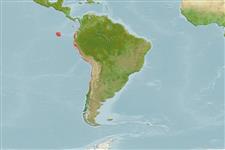>
Clupeiformes (Herrings) >
Clupeidae (Herrings, shads, sardines, menhadens)
Etymology: Ethmidium: Diminutive of Greek, ethmos, -ou = sieve or ethmoides bone (Ref. 45335).
More on author: Valenciennes.
Environment: milieu / climate zone / depth range / distribution range
Écologie
marin; profondeur 0 - 50 m (Ref. 188). Tropical; 0° - 37°S, 86°W - 70°W (Ref. 188)
Southwest Pacific: Peru (Puerto Pizarro in Gulf of Guayaquil to Callao and Pisco Bay; presumably to border with Chile, but no records) and Chile (whole coast south to Talcahuano).
Length at first maturity / Taille / Poids / Âge
Maturity: Lm 25.4 range ? - ? cm
Max length : 31.2 cm TL mâle / non sexé; (Ref. 122662)
Épines dorsales (Total): 0; Épines anales 0; Rayons mous anaux: 12 - 15. Scutes present along back (before dorsal fin) as well as along belly. Upper jaw with median notch. Gill rakers fine and slender, about 130 to 150 in lower limb. Anal fin short, well behind last dorsal fin ray. Scales with pectinated hind border. A dark spot behind gill cover and up to 4 series of vertically oval spots along flank.
Occurs in coastal waters, forming large schools. Feeds by filtering phytoplankton (diatoms) and zooplankton (especially copepods), but will also take small fishes and crustaceans. Breeds in spring (Chile), depositing its eggs in coastal waters on sand, to which the sticky eggs cling, the larvae rising and joining the surface plankton on hatching. Marketed fresh, frozen, or canned.
Whitehead, P.J.P., 1985. FAO Species Catalogue. Vol. 7. Clupeoid fishes of the world (suborder Clupeoidei). An annotated and illustrated catalogue of the herrings, sardines, pilchards, sprats, shads, anchovies and wolf-herrings. FAO Fish. Synop. 125(7/1):1-303. Rome: FAO. (Ref. 188)
Statut dans la liste rouge de l'IUCN (Ref. 130435)
Menace pour l'homme
Harmless
Utilisations par l'homme
Pêcheries: commercial
Plus d'informations
RéférencesAquacultureProfil d'aquacultureSouchesGénétiqueElectrophoresesHéritabilitéPathologiesTraitementNutrientsMass conversion
CollaborateursImagesStamps, Coins Misc.SonsCiguateraVitesseType de nageSurface branchialeOtolithesCerveauxVision
Outils
Articles particuliers
Télécharger en XML
Sources Internet
Estimates based on models
Preferred temperature (Ref.
123201): 11.3 - 23, mean 20 °C (based on 12 cells).
Phylogenetic diversity index (Ref.
82804): PD
50 = 1.0000 [Uniqueness, from 0.5 = low to 2.0 = high].
Bayesian length-weight: a=0.00724 (0.00435 - 0.01206), b=3.13 (2.98 - 3.28), in cm total length, based on LWR estimates for this species & (Sub)family-body (Ref.
93245).
Niveau trophique (Ref.
69278): 2.1 ±0.0 se; based on diet studies.
Résilience (Ref.
120179): Haut, temps minimum de doublement de population inférieur à 15 mois (Assuming tm=1).
Fishing Vulnerability (Ref.
59153): Low vulnerability (21 of 100).
Climate Vulnerability (Ref.
125649): High vulnerability (58 of 100).
Nutrients (Ref.
124155): Calcium = 205 [96, 359] mg/100g; Iron = 1.78 [0.96, 3.23] mg/100g; Protein = 18.5 [17.2, 19.7] %; Omega3 = 0.328 [0.181, 0.617] g/100g; Selenium = 49.3 [23.6, 108.2] μg/100g; VitaminA = 15.7 [4.7, 49.2] μg/100g; Zinc = 1.78 [1.21, 2.65] mg/100g (wet weight);
